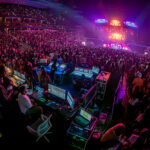
Boston’s Dropkick Murphys have been playing their brand of punk music, with a Celtic theme, since 1996. Having formed in Quincy, MA in 1996, they traditionally play their hometown area of Boston every St. Patrick’s Day. This year was to be no different as the beginning of March found them rehearsing in a facility for a run of shows to take place during that time. That was until the Covid-19 Virus brought all live shows to a halt.
Events United has a sound stage at their Derry, NH facility. While it wasn’t the House of Blues or an arena in the Boston area where the band likes to play to a packed house full of sweating fans, it was perfect for a hidden venue that their fans could not find. As the band proclaimed on their website, “For the first time in 24 years, we are not playing on St. Patrick’s Day weekend. The current world situation is the only thing that would ever stop us from doing so. So we came up with an idea we’re going to pull off this Tuesday — the night of St. Patrick’s Day (March 17)… We’re going to bring a DKM livestream concert to everyone — all over the world!!”

Tim Messina of Events United has a facility set up to offer such live casts of shows, having streamed everything from House of Worship services to impromptu shows before. He had the lights, audio and video equipment in house to offer the band their services. “It was a nonstop effort,” he states. “Everyone involved in this show pulled together in very short time; our team alone consisted of 25 production crew members. It felt amazing and stressful at the same time, accomplishing this in the face of everything going on today with the coronavirus. The energy in the studio was incredible. Maybe it was because of the immense amount of pressure to put on something so big in such a short amount of time, or maybe it was the combination of the Dropkick Murphys band and crew working so well with our team.”
The band had thought of doing some sort of podcast or show from their living room, using iPhones, etc. But the ideas snowballed from there. The idea for this show stemmed from a contract the band had to play for a Boston area software company named Pega, during one of their trade shows slated for the spring. The Pega folks had made a decision to move its show online. They made a suggestion that perhaps the band could perform virtually, as the trade show was headed in that direction.
As the story goes, management at this white collar firm are big fans of the band. The band has traditionally attracted a lot of blue collar union workers among their fans. Pega saw an opportunity to unite the white collar collegiate crowd with the blue collar workers in yet another example of Boston being strong. The group offered to help sponsor the event. As vocalist Casey says, “All of a sudden, it went from someone’s iPhone in your living room to the full thing.” From there, it took 48 hours to put the whole show together.
Streaming partners were glad to offer their services as Facebook, YouTube, Twitter and Twitch got onboard. Pollstar reported an estimated 322,000 people watched the show stream live. As of this writing, video of the live performance has been watched 10 million times.
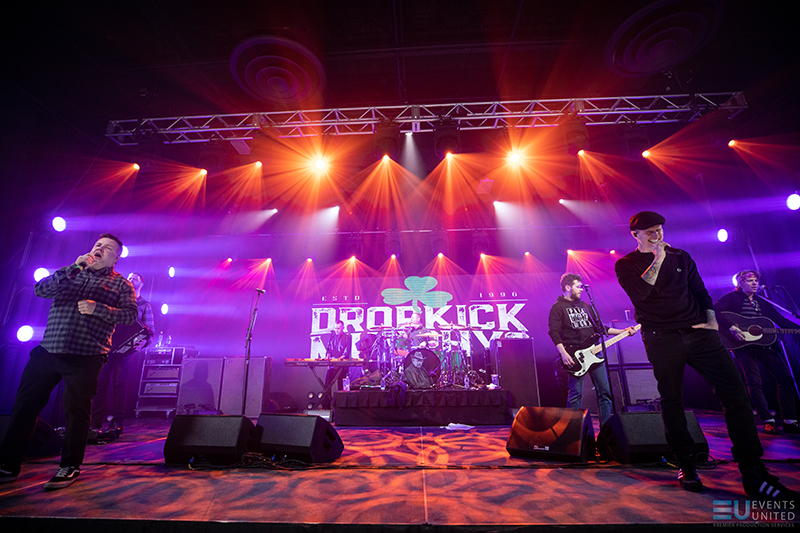
The Lighting
LD Brian Lareau let us know how he felt about lighting this show on a sound stage as opposed to a live audience, and the tools he used to make a light show that would look good on camera.
“First off, I’m so incredibly proud to have been involved in this. The show was so needed with everything going on in the world, and I think everyone knocked it out of the park. Thanks again to all who helped.

“We approached this particular event knowing that we would be making some adjustments for the live cameras, but it was important to the band to be able to maintain the overall feel and look from our usual concerts,” Lareau adds. “I brought in my own Avolites Expert Pro consoles I’ve been using for years, and the team at Events United put together a really solid lighting rig. They added the necessary foot lights, sky panels, and rear highlight fixtures to give us depth of field and consistent illumination for the cameras. After making sure we had the balance correct for that, running the rest of the show was business as usual. We had a full complement of Chauvet Maverick MK2 Spots, Strike 4 blinders, Ovation ellipsoidals and the [Ovation] CYC 1 FC units on the floor. Even some older Xeno 2500 strobes in front of the backline. In fact, I think the only non-Chauvet fixtures were the Arri SkyPanels and the Martin Mac Auras for our side wash.
“The only real difference in how the show was operated here versus any regular gig was limiting some quick solo bumps that you’d normally have. We were still able to capture all the dynamics from their faster songs to the more moody, down-tempo tracks. There were sections where I could pull back on the fill lighting to let some of the breakups take over, and we were able to keep a number of the tight blackout stops the band is used to seeing.
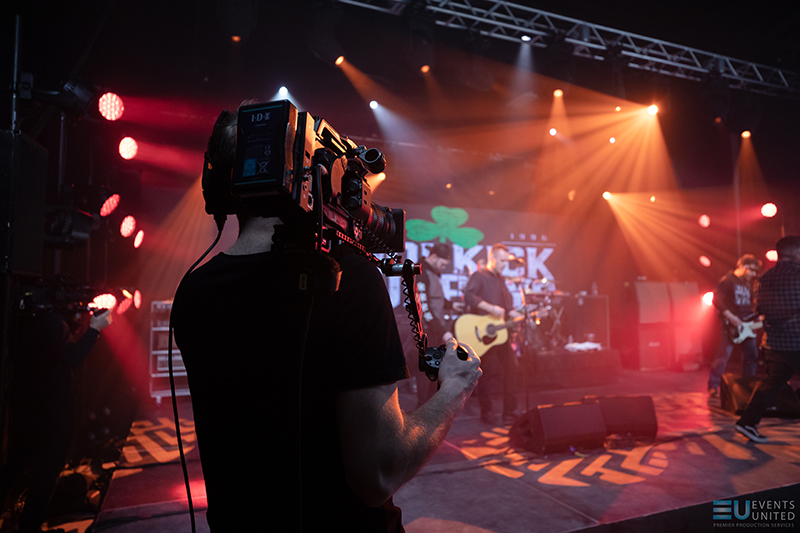
“Quite honestly, as simple as they are, the real star of this show? The Chauvet Strike 4 units that we placed on the floor upstage. They’re the only LED blinder I’ve found on the market that has the correct dimmer curve and fade out built in to look like conventional DWE lamps. There’s no additional funny business with cue timings or any other adjustments in console. You hit the flash button, and they react exactly how you expect.
“With those few mentioned changes, I programmed and operated the show to look and feel as if it were any other tour date. I kept the preview monitors in my field of view to make sure I wasn’t blowing anything out with the beams or dropping the fill too much. As far as I can tell, everyone is really happy with the results. Many thanks to everyone at Events United and Chauvet Professional for bringing it all together.”
Looking at fixture counts, the livestream rig was anchored by 20 Maverick MK2 Spot fixtures, which were used for effect lighting, with 10 of the new Ovation CYC 1 FC cyclorama lights (deployed as foot lights), eight Ovation E-260WW IP ellipsoidals, four Strike 4 blinders and 60 F2 LED video panels.
“We had to deal with a smaller stage here than you would normally find on a live venue stage, yet we had to give Brian the tools he needed to create big looks,” said Messina. “The output to size ratio of the Mavericks and low profile of the Ovation Cycs were essential. The whole lighting rig was designed to work well for camera. The brightness of all the lights, as well as the video wall, were crucial to make this work for broadcast.”
Beyond the specifics of the livestreamed show itself, the event has greater significance, points out Messina. “None of us have ever lived through a time like this,” he said. “How do you even begin to describe the challenge we’re facing as an industry. This is something that we should approach as an industry, not as competitors. We need to share ideas, whether they involve livestreaming or anything else. It’s important that we do what we can to keep moving forward until this all passes.” Meanwhile, thanks to this determined spirit, there is at least one tradition that has continued this spring despite the Coronavirus.
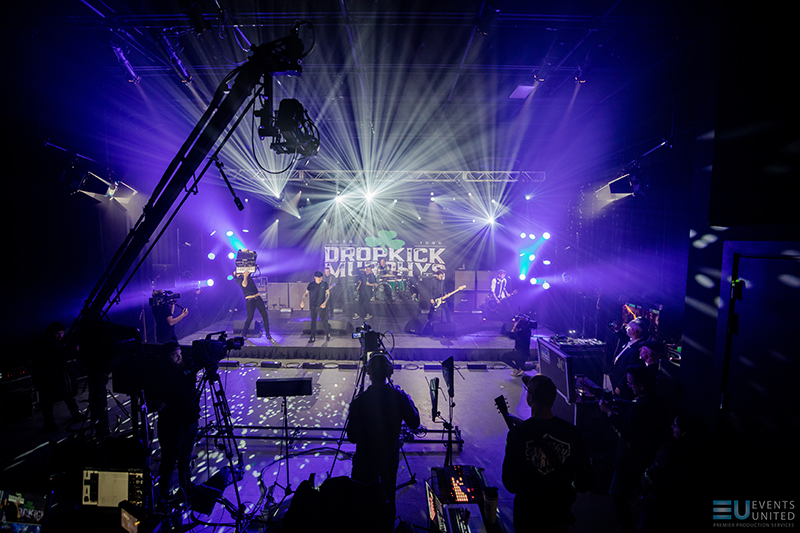
The Video
Events United video director Jon Martell, who worked with the camera operators and directed technical director Kent Rich, detailed the video setup. “We used all Sony cameras. Two PXW-X400s with Fujinon 17x lenses were used for the front shots, two HXC-FB75 cameras were used for the jib shot and slider shot, and three PXW-FS7 Mk1s were used for the handheld stage shots. The four broadcast cameras (X400s and FB75s) were shaded remotely with Sony HXCU-FB75 CCUs and RM-B170 remote panels. The camera slider was a Kessler CineDrive system mounted on a shuttle dolly and was fully automated.”
A Blackmagic Design Smart Videohub 40×40 12G router served as the hub of the live workflow. Seven cameras fed into the router, along with two computers for CG overlays and full screen video/graphics playback. Those feeds were routed into an ATEM 4 M/E Broadcast Studio 4K live production switcher connected to an ATEM 1 M/E Advanced Panel.
Switching the cameras, Kent Rich cut the main program on the ATEM 1 M/E Advanced Panel, which was then sent back to the router. From there, the feed was sent to encoders and to several of Blackmagic Design’s HyperDeck recorders, including four HyperDeck Studios, three HyperDeck Studio Minis, HyperDeck Studio Pro and HyperDeck Studio 12G. Each camera was ISO recorded, and there were two recordings made of the program cut as well, one being the primary and the other as the backup. Audio was ingested into the ATEM 4 M/E Broadcast Studio 4K through a Teranex Mini Audio to SDI converter.
“On the streaming side of things, we used a pair of Teradek Cube 655 encoders — one as primary and one as backup,” Martell said. “These encoders were sent to a dedicated Sputnik server on Teradek’s CORE platform, where the streams were then delivered to their final destinations — YouTube, Facebook, Twitch, and Twitter (via Periscope). Renewed Vision’s ProPresenter played back full-screen video content and slides and handled song titles. Video wall content was played back through ArKaos Grand VJ software and Pro Video Player.
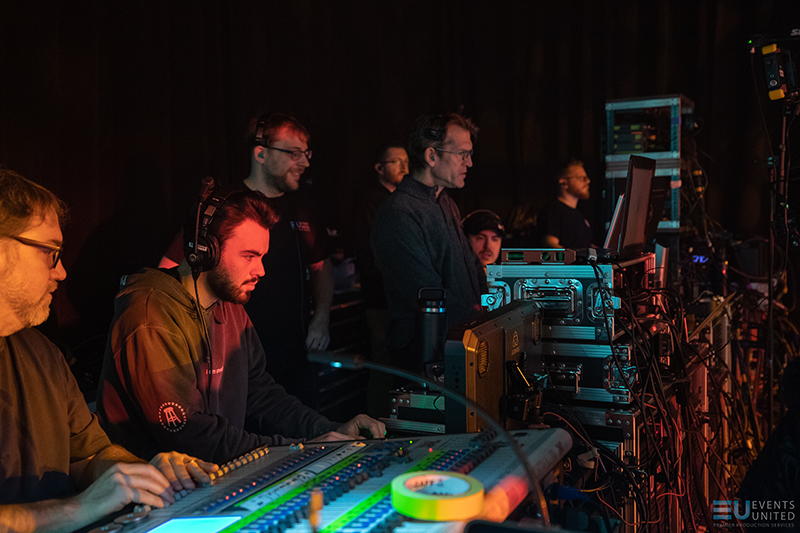
The FOH gang tries to keep their distanceThe audio system consisted of two Avid S6L consoles — one for the band’s monitor mixes, and one for the broadcast mix. Wedges were 12 d&b Audiotechnik M4’s powered by 4 D20 amplifiers. The drum fill consisted of 2 d&b Y8’s and a B4 sub. Side fills were two Q7’s.
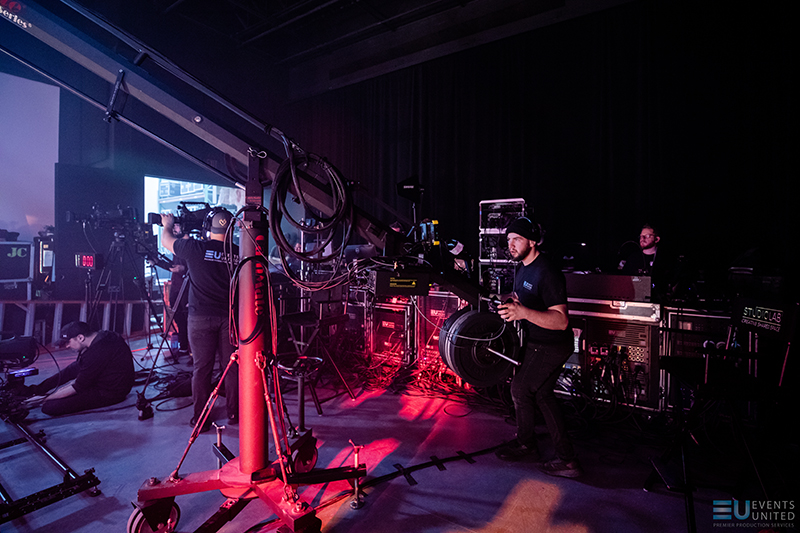
Dropkick Murphys St. Patrick’s Day 2020 Livestream
Crew
Events United:
- Producer: Tim Messina
- Production Manager: Donald Van Slyke
- Studio Manager: Benjamin Davis
- Audio Techs: Kevin Smith, Chase Clark
- Video Director: Jonathan Martell
- Technical Director: Kent Rich
- Camera Ops: Trifon Athnos (Camera Shader/Remote Camera Operator), Dustin Davis, Marc Therrien, Joel Pelletier (Camera/Jib Operator), Ian Messina, Greg Farnum, Andre Martinez
- Lighting Techs: Ryan Lane, Martin Lyons
Band crew:
- Production Manager: Grizz Middleton
- Lighting Designer: Brian Lareau
- Broadcast Audio Engineer: Pete Robertson
- Monitor Engineer: Jon Marcantonio
- Guitar Techs: Jay Cannava, Dave Stauble
Band:
- Vocals: Ken Casey, Al Barr
- Guitar and Banjo: Jeff DaRosa
- Guitar/Accordion/Keys: Tim Brennan
- Drums: Matt Kelly
- Guitar: James Lynch
- Bass: Kevin Rheault
Gear
- 1 Avo Pearl Expert console
- 20 Chauvet MK2 Spots for effect lighting
- 8 Chauvet Ovation ellipsoidals for specials
- 10 New CYC lights for foot lighting
- 4 Chauvet Strike 4’s
- 22 Martin MAC Auras
- 4 Arri S60C Sky Panels
- 1 Ultratec Radiance hazer
- 4 Xeno 2500 strobes
- 60 F2 Video panels
- 2 Teradek Cube 655 encoders
- 4 Blackmagic Design Hyperdeck Studio recorders
- 1 Blackmagic Design 40×40 12G Videohub router
- 1 Blackmagic Design ATEM 4 M/E Broadcast Studio 4K
- Atomos Shogun monitors
- 2 Sony PXW-X400s cameras with Fujinon 17x lenses
- 2 Sony HXC-FB75 cameras were used for the jib shots
- 3 Sony PXW-FS7 Mk1s for handheld cameras
- 1 Kessler CineDrive system mounted on a shuttle dolly


